
Fused cast AZS blocks are indispensable refractory materials at key parts of glass furnaces (such as the sidewalls, throats, and doghouses). Their outstanding resistance to erosion by glass liquid, high-temperature mechanical strength, and thermal shock resistance is attributed to the special microstructure formed by the electric fusion process - a framework of rutile (ZrO₂) embedded in the eutectic melt. However, the core manufacturing steps of casting and precise annealing, if not properly controlled, can easily introduce defects within or on the surface of the blocks, seriously compromising their service performance and service life. A thorough understanding of the causes of these defects and the implementation of systematic countermeasures are crucial for ensuring the intrinsic quality of fused cast AZS blocks.
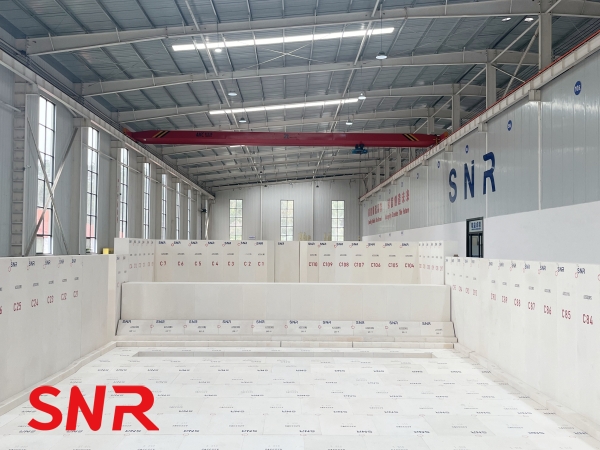
1. Casting process: root causes and comprehensive control of defects
Casting involves injecting a molten AZS material into a specific mold and controlling the solidification and shaping process. Defects at this stage mainly arise from the properties of the melt, the solidification behavior, thermal stress, and gas control.
(1) Cratering and macroscopic porosity: challenges of solidification shrinkage in AZS blocks
During the phase transition from liquid to solid state of the fused AZS melt, there is a significant volume contraction (with a linear contraction rate of approximately 10%-15%). If the molten metal liquid cannot continuously and effectively replenish this contraction, concentrated holes (craters) or a network of small pores (macroscopic porosity) will form in the final solidified areas, especially in the thick sections of the brick, the center of thermal joints, or the bottom of the riser neck. These defects not only directly reduce the effective bearing cross-section of the material but also become stress concentration points and preferred channels for erosion medium penetration, significantly reducing the high-temperature strength, thermal shock resistance, and erosion resistance of the brick.
Systematic overcoming strategies
►Scientifically design the riser system: This is the core solution for shrinkage cavities. Based on the brick structure, wall thickness distribution, and solidification simulation results, the quantity, position, shape, and size of the casting head must be precisely calculated. The casting heads must have sufficient volume and insulation/heating capacity to ensure that their solidification time is later than that of the brick body, continuously providing the filling liquid flow. At the same time, optimize the design of the casting head neck to ensure that the filling channel is unobstructed and effective.
►Optimize pouring process parameters: Strict control of pouring temperature is crucial. Too low a temperature will reduce the fluidity of the melt, and premature solidification will hinder the filling; too high a temperature will intensify melt shrinkage and gas dissolution, and may erode the mold. An appropriate pouring temperature should balance fluidity and shrinkage control. At the same time, adopt a stable and continuous pouring speed to avoid interruptions or turbulence, which is conducive to the realization of sequential solidification.
►Strengthen directional solidification control: Use "cold runners" (usually metal blocks with excellent thermal conductivity or special coatings) placed at the thick parts of the casting or near the heat junction to accelerate the cooling of this area, artificially creating a temperature gradient, guiding the solidification to progress sequentially from the area away from the riser towards the riser, forcing the shrinkage cavities to concentrate in the risers. Optimizing the material and structural design of the mold itself can also promote more uniform or directional heat dissipation.
(2) Porosity: the invisible enemy of melt and environment
Porosity defects mainly originate from three aspects: gases dissolved in AZS melt (mainly H₂, N₂, O₂ and their compounds) precipitating during solidification; moisture, organic matter or binders in the mold, core or coating decomposing at high temperatures to produce gases; and unreasonable design of the gating system causing metal liquid to entrain air or form negative pressure to draw in gases. The presence of porosity disrupts the continuity of the matrix, becoming the initiation point of cracks and the breakthrough point for erosion, especially posing a significant threat to the thermal shock resistance and erosion resistance of the brick body.
Systematic overcoming strategies
►Source purification: Adequate refining treatment of the AZS melt before pouring is a crucial step. Common methods include blowing inert gases (such as argon) to remove dissolved gases by the principle of bubble flotation, or, where conditions permit, using vacuum pouring technology to promote the escape of dissolved gases under low-pressure conditions.
►Thorough drying of the mold system: The mold, core, and all coatings must be subjected to long-term, thorough, high-temperature drying before pouring to completely remove physical and crystalline water, decompose and expel organic matter residues, and eliminate internal gas sources. Establish strict mold drying process regulations and inspection standards.
►Optimization of gating system dynamics design: Adopt bottom pouring or stepped pouring systems to ensure the melt fills the mold cavity smoothly from bottom to top, reducing splashing and turbulence, and lowering the risk of gas entrainment. Reasonably set the cross-sectional area ratios of the sprue, runner, and inner gate to ensure sufficient slag-blocking capacity. Install an adequate number and size of vent holes, vent risers, or permeable plugs at the highest points of the mold cavity or areas prone to gas accumulation to ensure smooth gas escape.
►Environmental control: Pouring operations should be conducted in a dry, low-humidity environment as much as possible to minimize the influence of environmental moisture.
(3) Cracks: the consequences of thermal stress and mechanical obstacles
Cracks during the casting stage can be classified into two types:
Thermal cracks: Occur during the final stage of solidification or shortly after solidification at high temperatures (when the material has low plasticity and poor strength). The main reason is that the solidification shrinkage is hindered (such as poor retentiveness of the mold or core, or poor design of the casting structure leading to restricted shrinkage), and the tensile stress generated exceeds the thermal strength limit of the material at that temperature. Cracks typically extend along grain boundaries and are in a tortuous shape.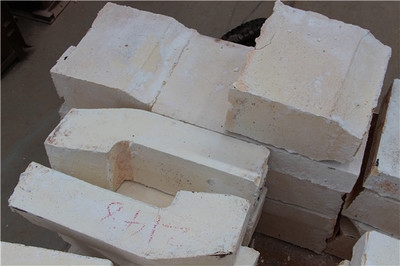
Cold cracks: Occur during the cooling process after the casting has completely solidified (often at a lower temperature). They are mainly caused by excessive thermal stress (rapid cooling rate, large temperature gradient) or organizational stress (volume changes caused by phase transformation) exceeding the low-temperature strength limit of the material. Cracks typically extend through grains and are relatively straight.
Systematic overcoming strategies
►Improve mold retentiveness: Select molding materials with good high-temperature retentiveness, such as resin sand, sodium silicate sand, or organic binder sand molds, or add retentive materials like sawdust or foam plastic to areas prone to shrinkage in the mold.
►Optimize brick structure design: Avoid sharp corners, sudden changes in cross-section, and unnecessary thickness differences. Use large, rounded corners for smooth transitions and distribute stress concentration. Reasonably design the positions of reinforcing ribs and bosses to avoid forming new thermal joints and shrinkage obstruction points.
►Precisely control the cooling process: After pouring, during the high-temperature stage when the casting is in a plastic state (especially in the early stage after solidification), avoid rapid cooling. This can be achieved by covering the mold with insulation materials or placing it in a slow-cooling pit. For large or complex molds, controlling the mold temperature is also crucial.
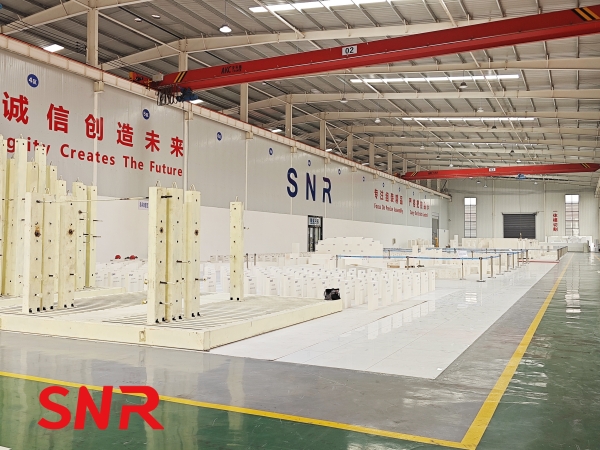
►Set up crack prevention structural elements: In areas prone to cracking (such as corners and thin-thick junctions), install temporary process reinforcing ribs or crack prevention ribs. Remove them after the casting has completely cooled.
2. Precision annealing: the key to eliminating stress and stabilizing structure
Annealing is a heat treatment process in which the cast fused cast AZS blocks are placed in a specific temperature system for a long time and slowly cooled. Its core goal is to eliminate or homogenize the huge internal stress generated during casting and solidification to the greatest extent, prevent cracking during subsequent cooling or processing and use; at the same time, promote and stabilize the crystal phase structure (especially the crystal transformation of ZrO₂ and the crystallization of the glass phase), and optimize the final performance of the material. Improper annealing will introduce new defects or aggravate the harm of casting defects.
Excessive residual stress and cracking: the fatal impact of cooling rate
This is the most critical risk during the annealing process. For AZS materials, during the cooling process, especially in the so-called "dangerous temperature range" (typically within 800°C to 1200°C), where their elastic modulus increases sharply and plasticity significantly decreases, they are extremely sensitive to the external cooling rate. If the cooling rate is too fast in this range, different parts of the brick body will have significant temperature differences due to heat dissipation differences, resulting in inconsistent thermal expansion/contraction and thus generating huge thermal stress (temperature difference stress). At this time, the material has extremely poor plasticity and cannot effectively release the stress through creep deformation. When the accumulated stress exceeds the tensile strength limit of the material at this temperature, cracking occurs. Such cracks often become apparent after annealing or during subsequent cutting, transportation, or even during the initial use.
Systematic overcoming strategy
►Establish and strictly implement a scientific annealing curve: This is very important. The annealing curve (temperature-time relationship) must be calculated and verified rigorously. The key lies in strictly controlling the cooling rate in the dangerous temperature range, usually requiring an extremely slow rate (for example, <1°C/h, the specific rate depends on the size of the brick shape, wall thickness difference, and AZS grade). At the phase transformation point (such as the transformation point from the tetragonal phase to the monoclinic phase of ZrO₂ ~ 1000°C), a slower rate or short-term holding may be required. The entire cooling process should follow the principle of "slow cooling at high temperatures, slightly faster at low temperatures". The setting of the heating stage and the holding stage (usually at the highest annealing temperature, such as 1450-1550°C) also needs to be reasonable to ensure uniform temperature penetration and initial stress relaxation.
►Ensure the high uniformity of the furnace temperature: Select a dedicated annealing furnace with high temperature control accuracy and excellent furnace temperature uniformity (usually ±5°C or better). Regularly conduct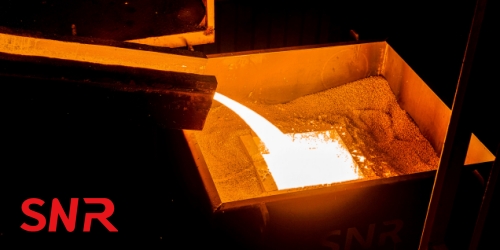 temperature field uniformity tests and calibrations of the furnace. The stacking method of the bricks is crucial for the air flow channel, and it must ensure that the hot air flow can uniformly pass through each surface of each brick, avoiding dead corners and local overheating/overcooling. Large bricks or specially shaped bricks require special consideration of the stacking scheme.
temperature field uniformity tests and calibrations of the furnace. The stacking method of the bricks is crucial for the air flow channel, and it must ensure that the hot air flow can uniformly pass through each surface of each brick, avoiding dead corners and local overheating/overcooling. Large bricks or specially shaped bricks require special consideration of the stacking scheme.
►Insulation strategy for key temperature points: Perform sufficient insulation at the highest annealing temperature point to make the overall temperature of the brick uniform and promote partial stress relaxation. At the phase transformation point or key temperature points where stress release is difficult, a short-term insulation platform can be considered to further promote stress release and temperature equilibrium.
►Application of advanced annealing technology: For extremely large, ultra-thick-walled, or extremely complex fused cast AZS blocks, conventional annealing furnaces may not meet the uniformity requirements. Consider using zone-controlled temperature annealing kilns, in-furnace cooling insulation boxes, or local auxiliary heating/cooling devices to achieve precise control of the cooling rate in different areas of the brick.
Insufficient phase transformation and performance risks: ensuring structural stability
During the cooling process of AZS, complex phase transformations occur, especially the crystal structure transformation of ZrO₂ (cubic phase → tetragonal phase → monoclinic phase) and the crystallization behavior of the glass phase. These phase transformations are accompanied by volume changes. If the annealing regime (especially the maximum temperature, holding time, and cooling rate through the phase transformation zone) fails to effectively promote the sufficient and smooth occurrence of the required phases, it may lead to: the presence of residual unstable phases (such as untransformed tetragonal ZrO₂), which may cause delayed phase transformation during use, resulting in volume changes, leading to microcracks or even macrocracks. Inhomogeneous distribution of the glass phase or insufficient crystallization affects its high-temperature viscosity and the wetting and encapsulation effect on the oblique zirconium oxide grains, reducing erosion resistance. Residual internal stress not being eliminated may pose a hidden risk for subsequent use.
Systematic overcoming strategies
►Optimize the annealing temperature regime to match the phase transformation: The maximum annealing temperature should be sufficiently high, with sufficient holding time to ensure sufficient phase transformation driving force and adequate time. The cooling rate in the temperature range sensitive to phase transformation (such as the phase transformation zone of ZrO₂ and the crystallization zone of the glass phase) must be specially finely controlled, avoiding excessive stress cracking while considering the needs of phase transformation kinetics.
►Precise temperature monitoring and recording: Set high-precision temperature measurement points at key positions in the annealing furnace and inside large bricks (if necessary, pre-bury thermocouples), to monitor and record the temperature changes throughout the annealing process in real time, ensuring that the actual temperature curve strictly conforms to the set process. Establish a complete temperature data recording and traceability system.
►Based on analysis, process verification, and adjustment: Regularly sample and analyze the bricks after annealing, evaluate the completion degree of phase transformation, and the stability of the structure. Use the analysis results to optimize the annealing process parameters.
Transformation: balance between high-temperature plasticity and support
During the annealing stage at high temperatures (especially in regions above 1000°C), AZS materials exhibit certain plasticity (creep). If the bricks are improperly stacked in the furnace, under the long-term effect of high temperature and self-weight, creep deformation may occur. Additionally, severe temperature non-uniformity in the furnace can also cause inconsistent contraction in different parts of the bricks, leading to distortion. Deformation not only affects the dimensional accuracy of the product and the construction quality, but may also cause abnormal stress distribution within the material.
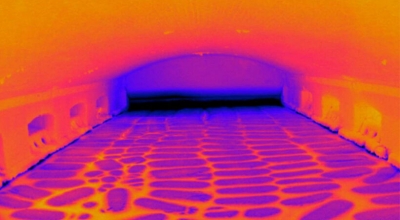
Systematic overcoming strategies
►Scientific stacking and stable support: Design specialized refractory pads, supports, or brackets to ensure that the bricks remain in a horizontal, stable, and uniformly stressed state throughout the annealing process. Support points should be placed at the parts of the bricks with better rigidity. Strictly control the stacking height to avoid excessive pressure on the lower bricks. Appropriate gaps should be left between the bricks to ensure air circulation.
►Uniform furnace temperature is the fundamental premise: As mentioned earlier, ensuring the high uniformity of the temperature field in the annealing furnace is the key foundation for preventing deformation caused by uneven shrinkage due to temperature differences.
►Optimize the staying time in the high-temperature phase: While ensuring the completion of necessary phase changes and stress elimination, it is necessary to avoid staying in the temperature range where the material is prone to significant creep (usually referring to the area close to or above 1200°C) for an excessively long time, in order to reduce the accumulation of creep deformation.
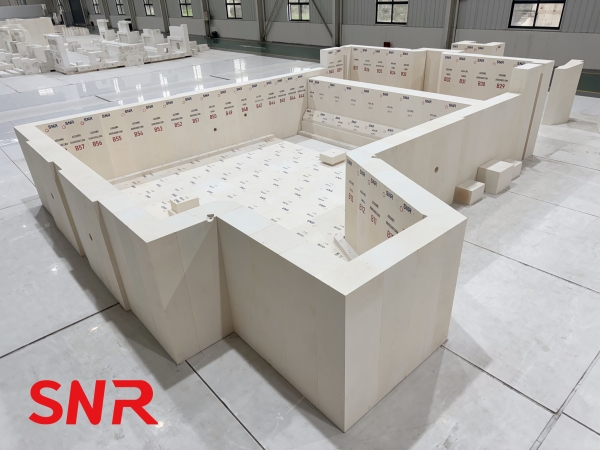
3. Establish a systematic quality assurance system to comprehensively overcome the defects in fused cast AZS block casting and annealing
During the production process of fused cast AZS blocks, the casting and annealing stages are like the key gears in a precision manufacturing chain. The quality of these stages directly determines the performance and reliability of the final product. However, to overcome various defects that occur during the casting and annealing processes of fused cast AZS blocks, it is impossible to achieve the goal merely through local improvements in a single stage. This requires the establishment of a systematic quality assurance system that runs through the entire manufacturing chain. From precise control of process parameters to strict selection of raw materials, from meticulous management of molds and equipment to multi-level quality inspection and monitoring, as well as continuous improvement and knowledge accumulation, every link is closely connected and indispensable, working together to ensure the production of high-quality fused cast AZS blocks.
Digitalization and precise control of process parameters: the foundation of process stability
Process parameters are the core elements in the production process of fused cast AZS blocks, and their stability directly affects the consistency of product quality. Implementing automatic monitoring, precise control, and complete recording of core parameters such as pouring temperature, pouring speed, mold temperature, temperature during each stage of annealing, and cooling rate is the key to achieving process stability and traceability.
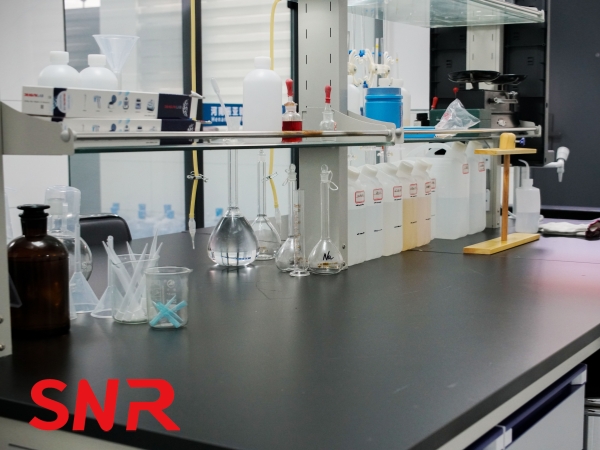
During the pouring process, excessively high pouring temperature may cause problems such as coarse grains and concentrated thermal stress in the brick body, while excessively low pouring temperature will make the slurry flowability worse, making it difficult to fill the mold and causing internal defects in the brick body. By installing high-precision temperature sensors on the pouring equipment to monitor the pouring temperature in real time and transmitting the data to the central control system, the central control system automatically adjusts the power of the heating device according to the preset process parameter range to ensure that the pouring temperature is always stable within the optimal range. At the same time, advanced flow control technology is used to precisely control the pouring speed, avoiding problems of uneven internal structure of the brick body due to excessive speed or slow speed.
The control of mold temperature is also not to be overlooked. Appropriate mold temperature can ensure that the slurry solidifies uniformly in the mold, reducing cracks and pores on the surface of the brick body.
The annealing process is a key step to eliminate internal thermal stress in the brick body and improve product stability. Precise control of the annealing temperature and cooling rate during each stage is crucial. By using an advanced annealing kiln temperature control system with multiple temperature monitoring points, real-time monitoring of temperature changes at different positions in the annealing kiln is carried out. The central control system automatically adjusts the operating parameters of the heating and cooling devices according to the preset annealing process curve to ensure uniform rising and falling of annealing temperature and, the cooling rate is strictly controlled within a reasonable range.
Stability and high quality of raw materials and auxiliary materials: the source of product quality
The quality of raw materials and auxiliary materials is the foundation for determining the performance of fused cast AZS blocks. Strictly controlling the chemical composition, particle size, and purity of main raw materials such as zircon sand and alumina powder is the primary task to ensure the stability of product quality. The content of zirconium in zircon sand, the content of aluminum in alumina powder, and the content of other impurity elements will have significant impacts on the chemical stability, high-temperature resistance, and erosion resistance of the brick body.
In addition to the main raw materials, the quality of auxiliary materials such as mold materials, binders, and coatings cannot be ignored either. Selecting reliable and batch-stable auxiliary materials can effectively avoid brick surface defects and internal structure problems caused by fluctuations in auxiliary material quality. For example, the particle size, shape and hardness of zircon sand and corundum sand will affect the air permeability and strength of the mold, the bonding performance and curing time of the binder will affect the molding quality of the mold, and the coating adhesion and fire resistance of the coating will affect the smoothness of the brick surface and erosion resistance. Therefore, in the selection of auxiliary materials, sufficient experiments and evaluations should be conducted, strict auxiliary material quality standards should be established, and the management and supervision of auxiliary material suppliers should be strengthened to ensure that each batch of auxiliary materials can meet production needs.
Lean management of molds and equipment: ensuring efficient production operations
Molds and equipment are crucial tools in the production of fused cast AZS blocks, and their performance and condition directly affect the quality and production efficiency of the products. Ensuring high-dimensional accuracy, good surface condition, and sufficient rigidity of the molds is a prerequisite for producing fused cast AZS blocks with accurate dimensions and smooth surfaces. During the mold design stage, the structural characteristics of the brick and the production process requirements should be fully considered, and advanced mold design software should be used for optimization design to ensure that the mold structure is reasonable, easy to process, and assemble. During the mold manufacturing process, high-precision processing equipment and processes should be selected, and the size tolerances and surface roughness of the molds should be strictly controlled to ensure that the mold quality meets the design requirements.
Establishing strict mold usage, maintenance, and scrapping systems is the key to extending the service life of molds 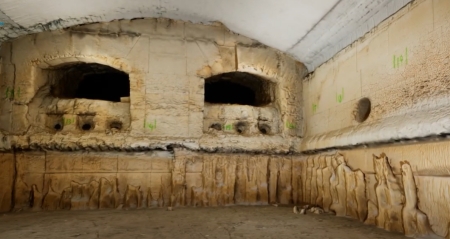 and ensuring stable mold performance. Before using the molds, a comprehensive inspection and debugging of the molds should be carried out to ensure that all performance indicators of the molds meet the production requirements. During use, the molds should be used correctly according to the prescribed operating procedures to avoid damage caused by improper operation. Regular maintenance and upkeep of the molds should be carried out, and the residual substances on the mold surface should be cleaned, and the worn parts of the molds should be repaired and replaced to ensure the good condition of the molds. When the molds reach their service life or suffer severe damage that cannot be repaired, they should be promptly scrapped to avoid affecting product quality with substandard molds.
and ensuring stable mold performance. Before using the molds, a comprehensive inspection and debugging of the molds should be carried out to ensure that all performance indicators of the molds meet the production requirements. During use, the molds should be used correctly according to the prescribed operating procedures to avoid damage caused by improper operation. Regular maintenance and upkeep of the molds should be carried out, and the residual substances on the mold surface should be cleaned, and the worn parts of the molds should be repaired and replaced to ensure the good condition of the molds. When the molds reach their service life or suffer severe damage that cannot be repaired, they should be promptly scrapped to avoid affecting product quality with substandard molds.
The pouring equipment, annealing furnaces, and their temperature control systems are the core equipment in the production of fused cast AZS blocks, and their performance and accuracy directly affect the quality and production efficiency of the products. Regular maintenance, calibration, and performance verification of the pouring equipment are necessary to ensure the stable and reliable operation of the equipment. Regular inspections of the heating elements, furnace linings, and temperature control systems of the smelting furnaces should be conducted, damaged components should be replaced in time, and damaged parts of the furnace linings should be repaired to ensure the heating efficiency and temperature uniformity of the smelting furnaces.
Multilevel quality inspection and monitoring: the guardian of product quality
Establishing a full-process inspection system from raw material entry, process semi-finished products, to final finished products is an important means to ensure that the quality of fused cast AZS blocks meets the standard requirements. In the raw material entry stage, each batch of raw materials must be inspected strictly against quality standards. Only qualified raw materials can enter the production process. During the production process, regular spot checks of process semi-finished products should be conducted to promptly identify and solve quality problems that arise during production, and to prevent unqualified semi-finished products from flowing into the next process. In the final product inspection stage, multiple detection methods should be used to comprehensively test the various performance indicators of the products to ensure that the product quality meets the standard requirements.
Using non-destructive testing technology to detect internal shrinkage cavities, porosity, cracks, etc., is an important means to ensure product quality. X-ray flaw detection can display the location and size of defects in the brick body, while ultrasonic flaw detection can quickly and accurately detect defects in the brick body. Through the application of non-destructive testing technology, potential defects in the brick body can be detected in a non-destructive manner, providing a reliable basis for product quality assessment.
Comprehensive evaluation of product quality through size inspection, appearance inspection, and physical and chemical performance tests. Size inspection uses high-precision measuring instruments to ensure that the size accuracy of the brick body meets the design requirements. Appearance inspection is conducted through visual observation and magnifying glasses, checking for cracks, pores, missing edges, and corners on the surface of the brick body. Physical and chemical performance tests are important indicators for evaluating the quality of the brick body. Through professional testing equipment and methods, the volume density, apparent porosity rate, normal and high-temperature strength, thermal shock resistance, and resistance to glass liquid erosion of the brick body are tested to ensure that the performance of the brick body meets the requirements of product use.
Sampling inspection of phase composition and microstructure during annealing is an important method to understand the internal structure of the brick body and evaluate the quality of annealing. Analyzing the phase composition of the brick body using an X-ray diffractometer to understand the content and distribution of various crystal phases. Observing the microstructure of the brick body using a scanning electron microscope to analyze the size, shape, and arrangement of crystal grains, as well as the distribution and morphology of pores. Through sampling inspection of phase composition and microstructure, problems during the annealing process can be detected promptly, providing a basis for optimizing the annealing process.
All in all, establishing a systematic quality assurance system that runs through the entire manufacturing chain is the key to overcoming the defects in AZS brick casting and annealing, improving product quality and production efficiency. Through efforts such as digitization and precise control of process parameters, stable and high-quality raw materials and auxiliary materials, lean management of molds and equipment, multi-level quality inspection and monitoring, as well as continuous improvement and knowledge accumulation, the production process is continuously optimized, product quality stability is enhanced, and a solid foundation is laid for the sustainable development of the enterprise.
Conclusion
Fused cast AZS blocks serve as the "heart armor" of glass furnaces. Their outstanding performance is highly dependent on the ultimate control of internal defects during the casting and annealing processes. Casting defects such as shrinkage cavities, pores, and cracks directly undermine the material's density and continuity, while improper annealing can lead to residual stress, abnormal phase transformation, or deformation, which are like "time bombs" waiting to explode. A thorough understanding of the unique properties of AZS materials, including high melt viscosity, large solidification shrinkage, complex phase transformation behavior, and sensitivity to thermal stress, is the foundation for formulating effective countermeasures. Only through systematic process design optimization, precise control of key parameters, the application of advanced equipment, strict material management, and continuous quality improvement, and the formation of a precise manufacturing system covering the entire chain from "melting - casting - annealing - inspection", can various defects be minimized or eliminated to the greatest extent, and high-performance fused cast AZS blocks with dense and uniform internal structure, fully released stress, and stable and optimized phase composition be forged. This not only directly determines the service life of a single brick, but also concerns the operational stability of the entire glass furnaces, the quality of glass products, and the economic benefits of production. It is an important manifestation of the core competitiveness of refractory material manufacturers. The continuous exploration and refinement of casting and annealing processes is the eternal technical pursuit in the AZS refractory material field.
Henan SNR Refractory Co., Ltd (SNR) focuses on producing high-quality refractory materials. If you have any needs, please contact me.